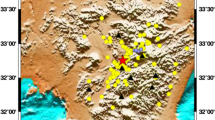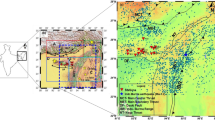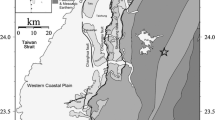Abstract
Strong ground motion simulation is a reliable tool for seismic hazard assessment and mitigation of any region. The distribution of hazards during an earthquake is greatly influenced by the attenuation properties of the medium. Typically, regional attenuation characteristic is employed for strong motion simulation rather than site-specific attenuation. In the current study, the newly developed semi-empirical simulation approach is modified to use a site-specific attenuation relation. Initially, the medium attenuation characteristics are quantified by estimating frequency-dependent S-wave quality factor \(({Q_\beta}(f))\) at each recording station. These obtained \({Q_\beta}(f)\) relations at each station are further utilised to estimate the regional relation for the Garhwal and Kumaon regions as (90±4)f(0.86±0.05) and (54±2)f(0.89±0.1), respectively. These values suggest that the Garhwal region is relatively less attenuative and more credible for seismic hazards compared to the Kumaon region. The \({Q_\beta}(f)\) obtained at each recording station are further used to simulate the 1991 Uttarkashi (Mw 6.8) and 2011 Indo-Nepal (Mw 5.4) earthquakes. An improved match is perceived between the observed and simulated records with site-specific \({Q_\beta}(f)\) values instead of regional ones. This comparison successfully validates the present modification in SET. This work provides insight into getting more realistic simulated results and explores recent trends in strong motion seismology for seismic hazard evaluation.










Similar content being viewed by others
References
Aki K 1980 Attenuation of shear waves in the lithosphere for frequencies from 0.05 to 25 Hz; Phys. Earth Planet. Int. 21 50–60.
Ambraseys N and Jackson D 2003 A note on early earthquakes in northern India and southern Tibet; Curr. Sci. 84 571–582.
Banerjee P and Bürgmann R 2002 Convergence across the northwest Himalaya from GPS measurements; Geophys. Res. Lett. 29(13) 1652.
Bilham R and Gaur V K 2000 The geodetic contribution to Indian seismotectonics; Curr. Sci. 79 1259–1269.
Boore D M 1983 Stochastic simulation of high frequency ground motion based on seismological models of radiated Spectra; Bull. Seismol. Soc. Am. 73 1865–1894.
Boore D M and Bommer J 2005 Processing of strong motion accelerograms: Needs, options and consequences; Soil Dyn. Earthq. Eng. 25 93–115.
Brune J N 1970 Tectonic stress and spectra of seismic shear waves from earthquakes; J. Geophys. Res. 75 4997–5009.
Celerier J, Harrison T M, Webb A A G and Yin A 2009 The Kumaun and Garwhal Lesser Himalaya, India: Part 1. Structure and stratigraphy; Bull. Geol. Soc. Am. 121 1262–1280.
Chopra S, Kumar V, Suthar A and Kumar P 2012 Modeling of strong ground motions for 1991 Uttarkashi, 1999 Chamoli earthquakes, and a hypothetical great earthquake in Garhwal–Kumaun Himalaya; Nat. Hazards 64(2) 1141–1159.
Demirci A and Bekler T 2022 Azimuthal path variations of regional body wave attenuation via Coda-source normalised method: An example from Eastern Marmara (NW Turkey); J. Earthq. Eng, https://doi.org/10.1080/13632469.2022.2030435.
Devi S, Sandeep, Kumar P and Monika 2021 Strong-motion simulation of the 1988 Indo-Burma and scenario earthquakes in NE India by integrating site effects in a semi-empirical technique; Pure Appl. Geophys. 178 2839–2854.
Devi S, Sandeep, Kumar P, Monika and Joshi A 2022 Modelling of 2016 Kumamoto earthquake by integrating site effect in semi-empirical technique; Nat. Hazards 111(3) 1–20.
Dewey J F and Burke K 1973 Tibetan, Variscan and Precambrian basement reactivation: Products of continental collision; J. Geol. 81 683–692.
Douglas J and Aochi H 2008 A survey of techniques for predicting earthquake ground motions for engineering purposes; Surv. Geophys. 29 187–220.
Farrokhi M, Hamzehloo H, Rahimi H and Allamehzadeh M 2015 Estimation of Coda-wave attenuation in the central and eastern Alborz, Iran; Bull. Seismol. Soc. Am. 105(3) 1756–1767.
Gansser A 1980 The significance of the Himalayan suture zone; Tectonophys. 62 37–52.
Gautam P K, Gahalaut V K, Prajapati S K, Naresh K, Yadav R K and Rana N 2017 Continuous GPS measurements of crustal deformation in Garhwal–Kumaun Himalaya; Quat. Int. 462 124–129.
Gupta S C and Kumar A 2002 Seismic wave attenuation characteristics of three Indian regions: A comparative study; Curr. Sci. 82 407–413.
Gupta S C, Singh V N and Kumar A 1995 Attenuation of Coda Waves, in the Garhwal Himalaya, India; Phys. Earth Planet. Interiors 87 247–253.
Hanks T C and McGuire R K 1981 The character of high-frequency ground motion; Bull. Seismol. Soc. Am. 71 2071–2095.
Hayashi S, Tsuchida H and Kurata E 1971 Average response spectra for various subsoil conditions; In: Proceedings of third joint meeting, US–Japan panel on wind and seismic effects. UJNR, Tokyo.
Heim A and Gansser A 1939 Central Himalaya, geological observation of the Swiss Expedition 1936; Hindustan Publishing Corporation (India), Delhi.
Irikura K 1986 Prediction of strong acceleration motion using empirical Green’s function; In: Proceedings of the 7th Japan earthquake engineering symposium, pp. 151–156.
Irikura K and Kamae K 1994 Estimation of strong ground motion in broad-frequency band based on a seismic source scaling model and an empirical Green’s function technique; Ann. Geofis. 6 1721–1743.
Jade S 2004 Estimates of plate velocity and crustal deformation in the Indian subcontinent using GPS geodesy; Curr. Sci. 86 1443–1448.
Jade S, Bhatt B C, Yang Z, Bendick R, Gaur V K and Molnar P 2004 GPS measurements from the Ladakh Himalaya, India: Preliminary tests of plate-like or continuous deformation in Tibet; Geol. Soc. Am. Bull. 116 1385–1391.
Jade S, Mukul M, Gaur V K, Kumar K, Shrungeshwar T S and Satyal G S 2014 Contemporary deformation in the Kashmir Himachal, Garhwal and Kumaon Himalaya: Significant insights from 1995–2008 GPS time series; J. Geod. 88 539–557.
Joshi A 2006 Use of acceleration spectra for determining the frequency dependent attenuation coefficient and source parameters; Bull. Seismol. Soc. Am. 96 2165–2180.
Joshi A and Midorikawa S 2004 A simplified method for simulation of strong ground motion using rupture model of the earthquake source; J. Seismol. 8 467–484.
Joshi A, Kumar B, Sinvhal A and Sinvhal H 1999 Generation of synthetic accelerograms by modeling of rupture plane; J. Earthq. Technol. 36 43–60.
Joshi A, Singh S and Giroti K 2001 The simulation of ground motions using envelope summations; Pure Appl. Geophys. 158 877–901.
Joshi A, Kumar P, Mohanty M, Bansal A R, Dimri V P and Chadha R K 2012 Determination of Qβ(f) at different places of Kumaon Himalaya from the inversion of spectral acceleration data; Pure Appl. Geophys. 169 1821–1845.
Kanamori H 1979 A semi empirical approach to prediction of long period ground motions from great earthquakes; Bull. Seismol. Soc. Am. 69 1645–1670.
Kanamori H and Anderson D L 1975 Theoretical basis of some empirical relations in seismology; Bull. Seismol. Soc. Am. 65 1073–1095.
Kayal J R 2008 Microearthquake seismology and seismotectonics of South Asia; Springer, 504p.
Khattri K N 1999 An evaluation of earthquakes hazard and risk in northern India; Him. Geol. 20 1–46.
Kumar A and Mittal H 2018 Strong-motion instrumentation: Current status and future scenario; Adv. Indian Earthq. Eng. Seismol., pp. 35–54.
Kumar P and Sandeep 2020 A review on Geophysical parameters comparison in Garhwal and Kumaun Himalaya region, India, Basics of Computational Geophysics, 1st edn., Elsevier, pp. 95–103.
Kumar D, Teotia S S and Khattari K N 1997 The representation of attenuation characteristics of strong ground motion observed in the 1996 Dharamshala and 1991 Uttarkashi earthquakes by available empirical relations; Curr. Sci. 73 543–548.
Kumar N, Parvez I A and Virk H S 2004 Estimation of coda waves attenuation for NW Himalayan region using local earthquakes; Research Report CM 0404, CSIR Centre for Mathematical Modelling and Computer Simulation (C-MMACS), Bangalore, India.
Kumar A, Mittal H, Sachdeva R and Kumar A 2012 Indian strong motion instrumentation network; Seismol. Res. Lett. 83(1) 59–66.
Kumar A, Baro O and Meena N L 2014 Estimation of surface PGA and determination of target values for no liquefaction at Guwahati city; Golden Jubilee Conference of the IGS Bangalore Chapter, Geo-Innovation 30–31 1–8.
Kumar P, Joshi A, Sandeep and Kumar A 2015a Three-dimensional attenuation structure in the region of Kumaon Himalaya, India based on inversion of strong motion data; Pure Appl. Geophys. 172(2) 333–358.
Kumar A, Sinvhal A, Joshi A, Kumar D, Sandeep and Kumar P 2015b Coda wave attenuation characteristics for Kumaon and Garhwal Himalaya, India; Nat. Hazards 75 1057–1074.
Kumar P, Joshi A, Sandeep, Kumar A and Chadha R K 2015c Detailed attenuation study of shear waves in the Kumaon Himalaya, India, using the inversion of strong-motion data; Bull. Seismol. Soc. Am. 105 1836–1851.
Kumar N, Kumar P, Chauhan V and Hazarika D 2017 Variable anelastic attenuation and site effect in estimating source parameters of various major earthquakes including Mw 7.8 Nepal and Mw 7.5 Hindu kush earthquake by using far-field strong-motion data; Int. J. Earth Sci. 106 2371–2386.
Kumar P, Devi S, Monika, Srivastava A, Sandeep, Joshi A and Kumari R 2019 Site response study based on H/V method using S-wave: A case study in the Kumaon Himalaya, India; Him. Geol. 40(2) 213–219.
Kumar P, Monika, Sandeep, Kumar S, Kumari R, Kumar D and Kumar N 2021 Characterisation of shear wave attenuation and site effects in the Garhwal Himalaya, India from inversion of strong motion records; J. Earth Syst. Sci. 130 186.
Larson K, Bürgmann R, Bilham R and Freymueller J T 1999 Kinematics of the India–Eurasia collision zone from GPS measurements; J. Geophys. Res. 104 1077–1093.
Lee W H K and Lahr J C 1975 HYPO 71: A computer program for determining hypocenter, magnitude and first motion pattern of local earthquakes; USGS Open-File Rep. 1–116.
Mahesh P, Rai S S, Sivaram K, Paul A, Gupta S, Sarma R and Gaur V K 2013 One-dimensional reference velocity model and precise locations of earthquake hypocenters in the Kumaon–Garhwal Himalaya; Bull. Seismol. Soc. Am. 103(1) 328–339.
Midorikawa S 1993 Semi empirical estimation of peak ground acceleration from large earthquakes; Tectonophysics 218 287–295.
Mittal H 2011 Estimation of ground motion in Delhi; Doctoral dissertation, Roorkee, India.
Mittal H and Kumar A 2014 Stochastic finite-fault modeling of Mw 5.4 earthquake along Uttarakhand–Nepal border; Nat. Hazards 75(2) 1145–1166.
Mittal H, Wu Y M, Kumar A and Sharma B 2016 Evaluating the effects of ground motion parameters on response spectra in Uttarakhand Himalayas, India; Arab. J. Geosci. 9 1–12.
Mittal H, Sharma B, Chao W A, Wu Y M, Lin T L and Chingtham P 2022 A comprehensive analysis of attenuation characteristics using strong ground motion records for the Central Seismic Gap Himalayan Region, India; J. Earthq. Eng. 26(5) 2599–2624.
Mohraz B 1976 A study of earthquake response spectra for different geological conditions; Bull. Seismol. Soc. Am. 66 915–935.
Monika, Kumar P, Sandeep, Kumar S, Joshi A and Devi S 2020 Spatial variability studies of attenuation characteristics of Qα and Qβ in Kumaon and Garhwal region of NW Himalaya; Nat. Hazards 103 1219–1237.
Negi S S, Paul A and Joshi A 2015 Body wave crustal attenuation characteristics in the Garhwal Himalaya, India; Pure Appl. Geophys. 172(6) 1451–1469.
Newmark N M and Hall W J 1969 Seismic design criteria for nuclear reactor facilities; In: Proceedings of fourth world conference earthquake engineering 345(B-4) 37–50.
Onishi Y, Horike M and Kawamoto Y A 2004 Method for simulating three-component, near-fault, strong ground motions using stochastic green’s function; 13th World Conference on Earthquake Engineering Vancouver, B.C., Canada August 1–6, 2678.
Paul J, Burgmann R, Gaur V K, Bilham R, Larson K M, Ananda M B, Jade S, Mukal M, Anupama T S, Satyal G, Kumar D 2001 The motion and active deformation of India; Geophys. Res. Lett. 28 647–651.
Paul A, Gupta S C and Pant C C 2003 Coda Q estimates for Kumaun Himalaya; Proc. Indian Acad Sci. Earth Planet. Sci. 112 569–576.
Ponraj M, Miura S, Reddy C D, Amirtharaj S and Mahajan S H 2011 Slip distribution beneath the central and western Himalaya inferred from GPS observations; Geophys. J. Int. 185 724–736.
Sandeep, Joshi A, Kamal, Kumar P and Kumar A 2014a Effect of frequency dependent radiation pattern in simulation of high frequency ground motion of Tohoku earthquake using modified semi empirical method; Nat. Hazards 73 1499–1521.
Sandeep, Joshi A, Kamal, Kumar P and Kumari P 2014b Modeling of strong motion generation area of the Uttarkashi earthquake using modified semi-empirical approach; Nat. Hazards 3 2041–2066.
Sandeep, Joshi A, Lal S, Kumar P, Sah S K, Vandana and Kamal 2017 Simulation of strong ground motion of the 2009 Bhutan Earthquake using modified semi empirical technique; Pure Appl. Geophys. 174 4343–4356.
Sandeep, Joshi A, Sah S K, Kumar P, Lal S, Devi S and Monika 2019a Modeling of 2011 Indo-Nepal earthquake and scenario earthquakes in the Kumaon Region and comparative attenuation study using PGA distribution with the Garhwal Region; Pure Appl. Geophys. 176(1) 1–14.
Sandeep, Joshi A, Sah S K, Kumar P, Lal S and Kamal 2019b Modeling of strong motion generation areas for a great earthquake in central seismic gap (CSG) region of Himalaya using modified semi-empirical approach; J. Earth Syst. Sci. 128(100) 1–12.
Sandeep, Joshi A, Kumari P, Kumar P, Sah S K, Lal S and Singh N P 2020 Strong ground motion simulation techniques – A review in world context; Arab. J. Geosci. 13 673.
Sandeep, Devi S, Kumar P, Monika and Kumar R 2022 Strong motion modelling of 1999 Izmit earthquake using site effect in semi empirical technique: A more realistic approach; Pure Appl. Geophys. 179 483–497.
Sato H and Fehler M C 1998 Seismic wave propagation and scattering in the heterogeneous Earth; American Institute of Physics Press, New York.
Seeber L and Armbruster J G 1981 Great detachment earthquakes along the Himalayan arc and long-term forecasting; In: Earthquake prediction: An international review; Maurice Ewing Series 4; American Geophysical Union, Washington, D.C., pp. 259–277.
Seed H B, Ugas C and Lysmer J 1976 Site dependent spectra for earthquake-resistant design; Bull. Seismol. Soc. Am. 66 221–243.
Sharma M L and Bungum H 2006 New strong ground-motion spectral acceleration relations for the Himalayan region; 13th ECEE and 30th General Assembly of the ESC, Geneva, Switzerland, 3–8 September 1459.
Sharma B, Teotia S S, Kumar D and Raju P S 2009 Attenuation of P- and S-waves in the Chamoli Region, Himalaya, India; Pure Appl. Geophys. 166 1949–1966.
Sharma B, Chopra S, Sutar A K and Bansal B K 2013 Estimation of strong ground motion from a great earthquake Mw 8.5 in central seismic gap region, Himalaya (India) using empirical Green’s function technique; Pure Appl. Geophys. 174 2127–2138.
Sharma J, Chopra S and Roy K S 2014 Estimation of source parameters, quality factor (QS), and site characteristics using accelerograms: Uttarakhand Himalaya Region; Bull. Seismol. Soc. Am. 104(1) 360–380.
Singh C, Singh A, Bharathi V K S, Bansal A R and Chadha R K 2012 Frequency-dependent body wave attenuation characteristics in the Kumaun Himalaya; Tectonophysics 524 37–42.
Singh R, Paul A, Kumar A, Kumar P and Sundriyal Y P 2018 Estimation and applicability of attenuation characteristics for source parameters and scaling relations in the Garhwal Kumaun Himalaya region, India; J. Asian Earth Sci. 159 42–59.
Srivastava P and Mitra G 1994 Thrust geometries and deep structure of the outer and lesser Himalaya, Kumaon and Garhwal (India): Implications for evolution of the Himalayan fold-and-thrust belt; Tectonics 13(1) 89–109.
Thakur V C and Kumar S 1994 Seismotectonics of the 20 October 1991 Uttarkashi earthquake in Garhwal, Himalaya, North India; Terra Nova 6(1) 90–94, https://doi.org/10.1111/j.1365-3121.1994.tb00637.x.
Valdiya K S 1980 Geology of the Kumaun Lesser Himalaya: Dehra Dun, India; Wadia Institute of Himalayan Geology 291.
Wells L D and Coppersmith K J 1994 New empirical relationships among magnitude, rupture length, rupture width, rupture area and surface displacement; Bull. Seismol. Soc. Am. 84 974–1002.
Yin A 2006 Cenozoic tectonic evolution of the Himalayan orogen as constrained by along-strike variation of structural geometry, exhumation history, and foreland sedimentation; Earth Sci. Rev. 76 1–131.
Yoshimoto K, Sat H and Ohtake M 1993 Frequency-dependent attenuation of P and S waves in the Kanto area, Japan, based on the coda-normalisation method; Geophys. J. Int. 114 165–174.
Yu G, Khattri K N, Anderson J G, Brune J N and Zeng Y 1995 Strong ground motion from the Uttarkashi, Himalaya, India, earthquake: Comparison of observations with synthetics using the composite source model; Bull. Seismol. Soc. Am. 85 31–50.
Zeng Y, Anderson J G and Su F 1994 A composite source model for computing realistic synthetic strong ground motions; Geophys. Res. Lett. 21 725–728.
Acknowledgements
The authors thank the Director, Wadia Institute of Himalayan Geology, Dehradun, India, for his support, inspiration, and amenities (reference no. WIHG/0286). Data used in this work is attained from WIHG network; Department of Earth Sciences, Indian Institute of Technology, Roorkee, India; COSMOS VDC (https://www.strongmotioncenter.org/vdc/scripts/default.plx) and www.pesmos.in, are sincerely acknowledged. The present work is an outcome of the project sanctioned by the Science and Engineering Research Board, Department of Science and Technology (DST), with Grant No. ECR/2017/000367. Authors Monika, Sandeep, and SD thankfully acknowledge the Dept. of Geophysics, Banaras Hindu University, Varanasi.
Author information
Authors and Affiliations
Contributions
Monika: Writing, data analysis, and results compilation; Sandeep: Interpretation, writing and editing; PK: Conception, writing original draft, review and editing; SD: Software handling and data compilation; AJ: Data acquisition and processing.
Corresponding author
Additional information
Communicated by Sagarika Mukhopadhyay
Supplementary material pertaining to this article is available on the Journal of Earth System Science website (http://www.ias.ac.in/Journals/Journal_of_Earth_System_Science).
Supplementary information
Rights and permissions
About this article
Cite this article
Monika, Sandeep, Kumar, P. et al. Modelling of 1991 Uttarkashi and 2011 Indo-Nepal earthquakes using the modified semi-empirical technique by integrating site-specific quality factor. J Earth Syst Sci 132, 189 (2023). https://doi.org/10.1007/s12040-023-02201-2
Received:
Revised:
Accepted:
Published:
DOI: https://doi.org/10.1007/s12040-023-02201-2




